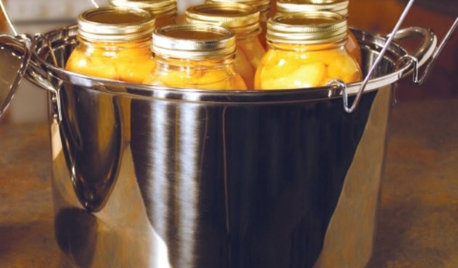Best canning/ preserving books?
Christina818
10 years ago
Related Stories

PRODUCT PICKSGuest Picks: Canning, Preserving, Steaming, Dehydrating
20 products to help make fall produce last through the season and beyond
Full Story
SHOP HOUZZShop Houzz: Mason Jars for More Than Canning
From lighting to artwork to kitchen accessories, get your hands on some Mason jar charm
Full Story0

ORGANIZINGSimple Pleasures: Preserving Analog Memories in a Digital World
Too often our photos and mementos accumulate in computers and in piles. Here’s how to free them up to be displayed and enjoyed
Full Story
KITCHEN DESIGNKitchen of the Week: Preserving Period Charm in Atlanta
Additions and updates to this kitchen respect the past while meeting the owner's needs in the present
Full Story
ARCHITECTUREHouzz Tour: Preserving an Untouched Hollingsworth Gem
Heritage status and an architecture-loving homeowner keep a midcentury modern ranch’s spirit alive
Full Story
DECORATING GUIDESNovel Ways With Bedroom Books
Reading and relaxing go hand in hand. See how designers are incorporating mini and all-out libraries in the bedroom
Full Story
BOOKSBook to Know: 'Long Island Modernism 1930-1980'
Photographs mix with social history from the architectural highlights of Long Island's suburbanization
Full Story
FEEL-GOOD HOME15 Cozy Book Nooks and What They Want You to Read
Put the beach reads away; these comfy spaces are creating a fall reading list. What books do they suggest to you?
Full Story
ARCHITECTUREMust-Have Book: ‘A Field Guide to American Houses’
Be the architectural historian of your neighborhood with this invaluable updated version of a well-researched classic
Full Story
BOOKSBook Tour: Contemporary New York City Architecture
John Hill's guide to NYC highlights the most notable homes and buildings from 2000-2010
Full Story





digdirt2
readinglady
Related Professionals
Holly Springs Landscape Architects & Landscape Designers · West Milford Landscape Architects & Landscape Designers · Salem Landscape Architects & Landscape Designers · Manchester Landscape Contractors · East Hanover Landscape Contractors · Golden Gate Landscape Contractors · Suitland Landscape Contractors · Thonotosassa Landscape Contractors · York Landscape Contractors · Sun Valley Landscape Contractors · Sauk Village Roofing & Gutters · Westchester Roofing & Gutters · Charlotte Driveway Installation & Maintenance · Chattanooga Driveway Installation & Maintenance · Fort Myers Driveway Installation & Maintenancemyfamilysfarm
Christina818Original Author
digdirt2
Christina818Original Author
readinglady
coffeehaus
malna
myfamilysfarm
digdirt2
myfamilysfarm
Christina818Original Author
myfamilysfarm
Christina818Original Author
sanschult
plantfreek
readinglady
digdirt2
malna
myfamilysfarm
digdirt2
readinglady
malna
myfamilysfarm
malna
readinglady
digdirt2
myfamilysfarm
2ajsmama
myfamilysfarm
kai615
readinglady
kai615
2ajsmama
kai615
myfamilysfarm
2ajsmama
digdirt2
2ajsmama